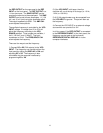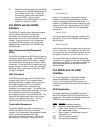25
characters again.
Reset
The Z command resets the unit to its default state.
The default front panel settings are listed in the
DEFAULTS section of the Guide to Operations.
In addition, the interface status returns to LOCAL,
the SRQ mask is cleared, the RS232 character
WAIT interval is set to 6, and the terminating
sequence is reset to the proper defaults.
The command and output buffers are cleared by
the Z command. Therefore, it is bad practice to
use the Z command before all previous commands
have been processed and all responses have
been received.
Trouble-Shooting Interface
Problems
If you are having difficulty getting your computer to
communicate with the SR530 look to the sections
on the RS232 and GPIB interfaces for some tips
specific to your particular interface.
An ASCII terminal is a valuable aid for debugging
interface problems. You can use it to:
1) become familiar with the SR530's
command structure,
2) see GPIB bus transactions by using the
GPIB echo mode,
3) eavesdrop on transactions when using the
RS232 interface,
4) substitute a human for the SR530 by using
a null modem cable ( to make the DTE a
DCE) and attaching the terminal to the
port to which you would normally have
connected the SR530. This allows you to
test your program's responses to inputs
which you provide from the terminal.
Common Hardware Problems include:
1) The RS232 or GPIB cables are not
properly attached.
2) The configuration switches for the RS232
characteristics or GPIB address are not
set correctly (Make sure the RS232 echo
is off when using the RS232 interface with
a computer. The GPIB with RS232 echo
mode should be off when not debugging
the GPIB interface.)
3) Your computer requires an RS232 control
line to be asserted, but your cable does
not pass it between the SR530 and the
computer, or, your computer is not
asserting the DTR line on the RS232.
Common Software Problems include:
1) You have sent the wrong command to ask
for data from the SR530. Your program
will wait forever for a response which is
not going to come. This may not be your
fault; we have seen Microsoft's Interpreted
Basic on the IBM PC occasionally send a
curly bracket (ASCII 253) when it was
supposed to have sent a carriage return
(ASCII 13).
2) Your computer's baud rate has been
changed and no longer matches the
SR530's baud rate.
3) The initial command sent to the SR530
was invalid due to a garbage character left
in the command queue from power-up, or,
the first character in you computer's UART
is garbage, also due to power-up. It is
good practice to send a few carriage
returns to the SR530 when your program
begins, and have your program clear-out
its UART at the start of your program.
4) The SR530 is not sending the correct
'end-of- record' marker for your computer.
For example, it appears that Microsoft's
Rev 3.2 FORTRAN on the IBM PC under
DOS 2.1 requires two carriage returns for
an end-of-record marker. The J command
can be used to set the SR530 end-of-
record marker to 2 carriage returns. [The
end-of-record marker is that sequence
which indicates that the response is
complete. From the keyboard, a single
carriage return is the end-of-record
marker.]
5) Answers are coming back from the SR530
too fast, overwriting the end-of-record
markers, and causing the computer to
hang waiting for a complete response. In
this case, the W command can be used to
slow down the response time of the
SR530 preventing overwriting.


















